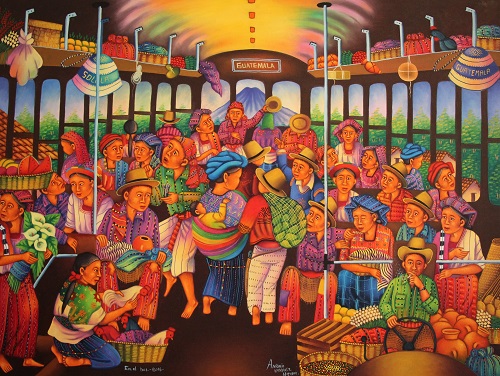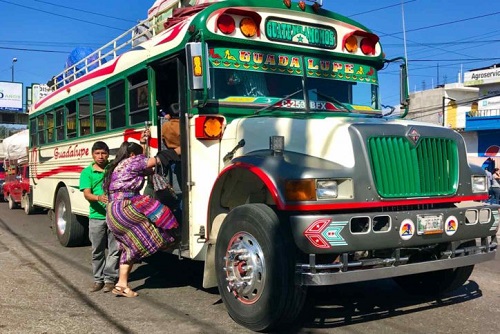
A Traveler’s Guide to the Chicken Bus in Guatemala
A chicken bus in Guatemala announces its arrival with bright lights, vivid shiny colors, unique swag, and loud music.
You see them flying down the road full-throttle announcing pick-ups and drop offs. All sorts of vendors, workers, travelers, and families use them as their choice of public transportation and can vouch for the adventure of riding a chicken bus in Guatemala.
Keep reading for a fascinating insight into the origin, cultural relevance, and the full breakdown of the unique experience of the chicken bus in Guatemala!
Why Do They Call it a Chicken Bus?
A chicken bus in Guatemala has multiple names.
Guatemalans call the chicken bus in Spanish la camioneta, la burra, or el bus. Other nicknames make reference to the route the bus follows, for example chicken buses that run from Guatemala City to Antigua are often called la antigueña. Chicken buses that run to Panajachel or San Pedro in Lake Atitlán are called las pedranas.
Foreign travelers refer to them as chicken buses because their cargo sometimes includes chickens or other live animals hitching a ride from town to town.
Animals aren’t the only thing that distinguishes these colorful buses. There’s also all types of merchandise being transported. Imagine the roof of the bus loaded up with bultos (baskets, bags, or boxes) that carry vegetables, fruits, flowers, textiles, and more.
The chofer (driver) has an assistant, known as el brocha. He’s in charge of collecting the fares from passengers and loading up the bultos on top of the bus. Brochas announce the stops, as well. The chicken bus in Guatemala runs on a tight schedule and requires the skills of intrepid and brave workers.
Where Do They Come From?
Chicken buses in Guatemala come from far away. They’re actually refurbished school buses from the United States.
These U.S. school buses are usually at least 10 years old and have over 150,000 miles on them. They’re auctioned at around $2,000 and sold to people who drive them all the way down to Guatemala.
Once the chicken bus arrives in Guatemala, it’s time for an extreme makeover!
The buses are taken to the shop, where they undergo mechanical repairs and a makeover. This is where the owner’s true creativity comes out. Depending on the bus line or route, the bus is embellished and airbrush painted with signature bright colors.
A chicken bus in Guatemala sports the name of a woman or of the bus line. If you’re ever traveling in the area, you’re sure to spot a green and red Esmeralda.
Impressive shiny bumpers and lights add extra swag and spice up the whole look of the chicken bus.
The chicken bus in Guatemala is the preferred choice of public transportation for connecting departamentos (provinces) and towns. They’re used throughout the country, and the number of people who ride them is way higher than those who own a car.
Learn more about the journey of a chicken bus in Guatemala by watching the documentary, La Camioneta.
How to Ride a Chicken Bus in Guatemala
Now it’s time to dive deep into the whole experience!
If you choose to take a chicken bus in Guatemala, be prepared for an adventure. Chicken buses are unconventional forms of transportation that require you pay in cash, unlike other forms of public transport that require a prepaid card. It’s always best to have small bills and change to pay your fare.
Once you locate the bus terminal or stop, ask around and keep your eyes open to spot the chicken bus you need to board. Signal them with a hand gesture, and if you’re carrying large cargo, the brocha will help you load your bultos on the roof. Otherwise you can keep your bag with you and place it in the luggage rack above your seat.
Once you get on, grab a spot quickly, even if you have to share a seat. Chicken buses in Guatemala have a tendency to fill up to capacity and beyond.

The brocha or ayudante de camioneta, will ask you where you get off once he begins collecting payment from passengers. You’ll be amazed to see how much money these guys carry in cash. They collect the pasaje (fees) from everyone who rides throughout the day.
A chicken bus in Guatemala doesn’t only have a flashy exterior, the equipment you’ll find inside is mindblowing, from amazing woofers, stereos, and neon lights, to flat screen TVs for entertainment. I once rode a chicken bus with a karaoke machine, and there was never a dull moment.
Merchants are sometimes allowed to sell food, drinks, and trinkets during the ride. There’s always a signature pan con pollo or pan con chile smell from the mamita selling freshly made sandwiches.
Even if the bus has its own soundtrack, it’s common to find a group of young people traveling with their own speaker. Many things happen at the same time on the camioneta!
Chicken Buses in Guatemala Aren’t For Everyone
A chicken bus in Guatemala gets you to your destination faster than you’d expect. This is because they tend to speed, even on curvy roads.
Be prepared for a bumpy ride with no seat belts. Mind your belongings to avoid being pickpocketed. Use your common sense and instinct to stay safe.
Many bus routes aren’t direct and require you to change buses multiple times. If you find yourself sharing a seat with lots of people, remember in Guatemala, we have the saying “donde cabe uno caben tres” (where you fit one, you fit three).
I would also skip the chicken buses that take you to the Pacific coast or el puerto (port). They get really hot and humid, and the experience can be overwhelming and unpleasant.
Fees and Schedules
To locate the schedules according to destination across Guatemala, visit this useful website. It lists the stops around the country, duration of the trip, and the bus line to take you there.
Unfortunately, few transportation companies have their own website, but those that do have complete information. If you ever find yourself in eastern Guatemala, find useful info on the Rutas Orientales website.
Asking around is an ideal option as well. Every chicken bus in Guatemala has an assigned terminal, like in the case of Antigua Guatemala. You just need to get there and ask which bus takes you to your preferred destination, and people will point you in the right direction.
Tours and Chicken Bus Adventures for Travelers
The chicken bus in Guatemala has become a staple of the country. Many adventurous travelers take a quick chicken bus ride from Antigua to Lake Atitlán to enjoy the experience. If you want to enjoy the experience in a shorter time, join one of the tours around Antigua Guatemala.
Authentic Chicken Bus Tour
This half-day excursion is ideal for exploring Antigua’s surroundings like a local. You’ll be able to visit a macadamia farm, the fabulous town of San Juan el Obispo, and get more insight into Guatemalan culture. This experience is available for booking on Viator.
Chicken Bus Tour by Niños de Guatemala
A nonprofit organization called Niños de Guatemala offers a great half-day experience where you visit a chicken bus workshop in Ciudad Vieja. This experience allows you to appreciate the whole transformation process. The tour can be booked on their website.
Learn Authentic Spanish from Guatemalans
Riding a chicken bus in Guatemala is an exhilarating and unique experience. Learning Spanish from Guatemalans who have experience on the subject is also guaranteed to prepare you for the whole experience.
Sign up for a free trial class with our certified, native, Spanish-speaking teachers from Guatemala. At Homeschool Spanish Academy, we offer flexible scheduling, tailored lessons, and work- or industry-related classes. We’ve been providing reliable service to Spanish learners for over 10 years. Don’t miss out on this marvelous opportunity. You’ll see after just one class how quickly your Spanish can improve.

Want to learn more about Latin American culture? Check out our latest posts!
- The Best Spanish Learning Podcasts for Kids
- 12 Contemporary Spanish Female Artists Who Will Empower You
- The History and Significance of Guatemalan Jade
- Are Bilingual Children More Likely to Experience a Speech or Language Delay?
- Top 10 Places to Visit in Guatemala City, Guatemala
- Learn About Hispanic History: Were Hispanics Slaves?
- Celebrating Culture and Joy: The Magic of Carnival in Spanish-Speaking Countries
- 15 Mouth-Watering National Dishes of Latin America
- Doing Chores at Home (Free Spanish Lessons for Kids) - February 5, 2025
- 12 Contemporary Spanish Female Artists Who Will Empower You - January 16, 2025
- 29 Cool and Catchy Spanish Phrases To Use With Friends [+Audio] - January 8, 2023






